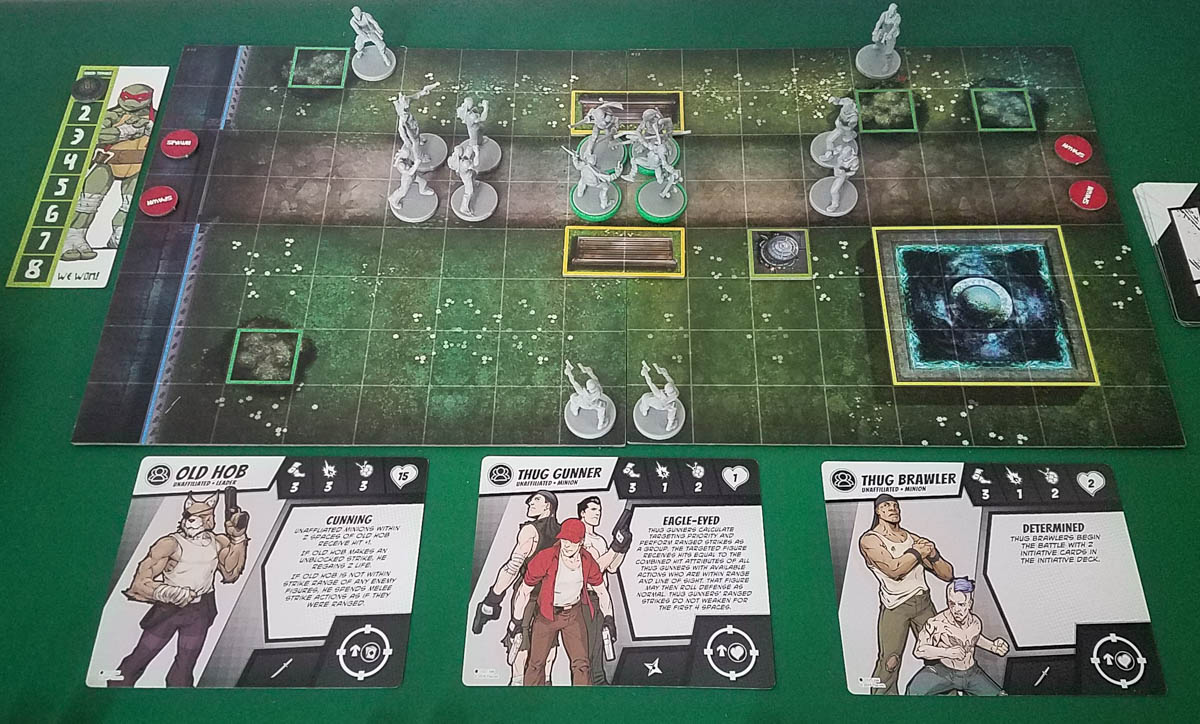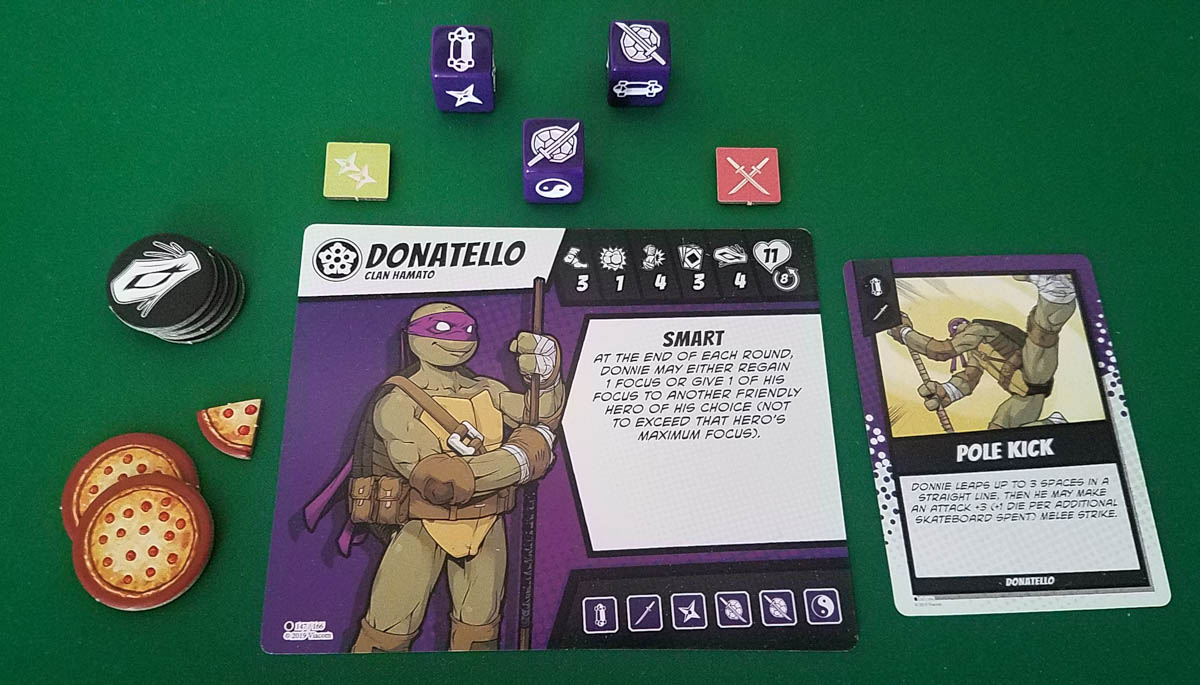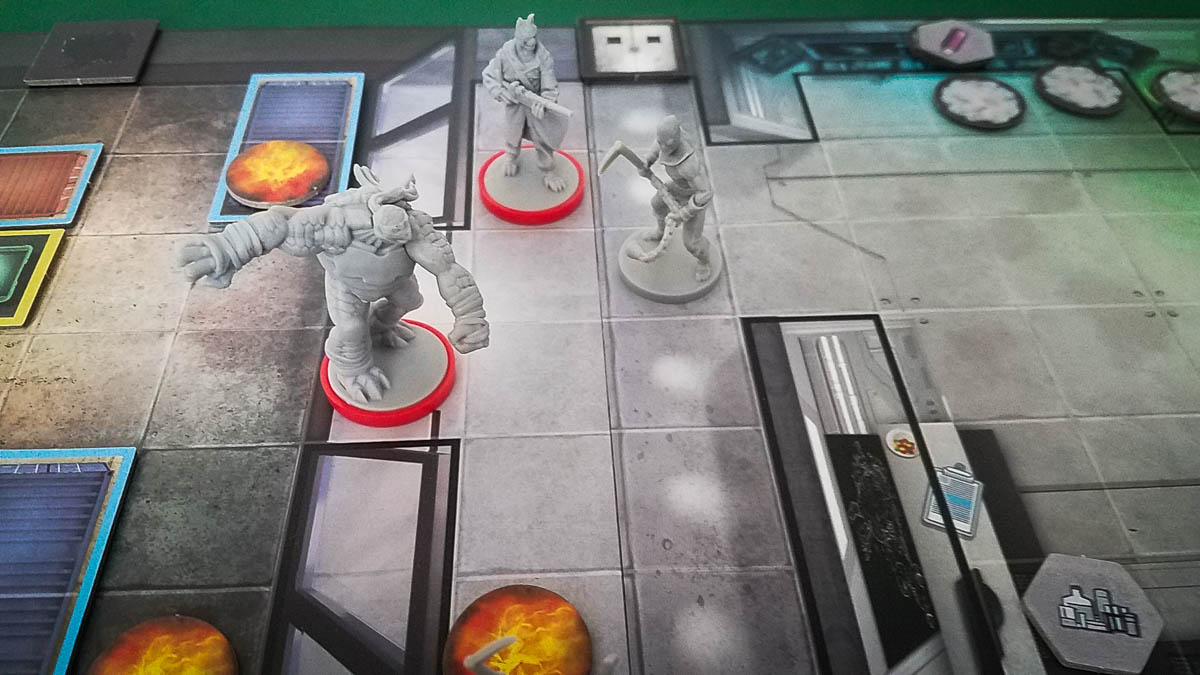Teenage Mutant Ninja Turtles Adventures Review
Year: 2020 | Players: 1-5 | Minutes: 45+ | Ages: 14+
This Teenage Mutant Ninja Turtles Adventures review was made after playing parts of Change is Constant and City Fall. We were sent these games by the publisher in exchange for an honest review.
What is TMNT Adventures?
Teenage Mutant Ninja Turtles Adventures are scenario-driven campaign games–based on IDW’s TMNT comic series–in which players battle with and against popular Ninja Turtles characters.
Change is Constant and City Fall were designed by Daniel Lansdown, Pete Walsh, and Kevin Wilson, and they are published by IDW Games.
Rules Overview
I’m going to be focusing on the fully cooperative mode here, but just know that in the One vs. Many mode one player controls the villains and uses ability cards to move the villains around and help them complete their objectives. Otherwise gameplay is pretty similar and you can play the majority of the scenarios in both modes.
You begin a game of TMNT Adventures by choosing a campaign in the Adventure Comic, which covers different stories from the TMNT comic book series. You can also easily play any of the scenarios as one-offs or play one of the standalone Arcade Battles. Each scenario includes the win conditions for the heroes and the villains, the number of figures that will be in the battle, and the map layout, which includes different terrain that can change what your heroes can see and how they can move around. You can use heroes from any of the TMNT Adventures games unless the scenario specifically says you can’t use certain ones.
Each hero has a Hero Sheet, unique Special Move cards, and a unique set of action dice. A Hero Sheet lists the icons found on that hero’s dice, their special ability, and their different attributes (movement, attack, defend, health, etc.). The Skill attribute tells you how many of your hero’s Special Move cards you can bring to the battle, and the Focus attribute tells you how many Focus (reroll) tokens you get.
Each round in co-op mode has three phases:
- Setup – Everyone rolls their action dice, optionally rerolls some dice (by spending Focus tokens), and then puts the dice in order so the two outside dice can be shared with the heroes sitting on either side of them. For example, if the hero to your right needs some extra attack, you can make sure that your far-right die is a katana so they’ll get a katana token. Anytime you roll a Chi icon, you get to gain Focus, attempt to heal, and then you rotate that die to any side.
- Battle – One by one, you draw cards from the Initiative deck, which will include cards for all of the heroes and the villains. If a villain’s card is drawn, all figures of that type will activate by moving toward and attacking heroes (if they have line of sight). Villain leaders get three actions per activation, while villain minions get two. When your hero’s card is drawn, you use the icons on your dice to perform actions, such as moving and attacking villains. When you attack, you roll a number of battle dice equal to your Attack attribute plus the number of attack icons on the action dice you’re activating. To get hits, you need to get enough successes to exceed the villain’s Defend attribute. You can choose to separate actions or combine them together; for example, you can combine two shuriken (ranged) dice to do one big attack or you can use them to do two weaker attacks. This is also the phase when you can play one of your Special Move cards, usually by spending one or more of your action dice.
- Clean-up – New enemies show up and then you set up the next round.
If a hero’s health is ever reduced to zero, they are “knocked down” and can attempt to “awaken” on their next turn by rolling dice equal to their Defend attribute plus some modifiers. If at any point every hero is knocked down, the heroes lose. The heroes also lose if the villains complete their win conditions before the heroes complete theirs.
That’s a basic overview of how the game plays. Check out the official rulebook on BGG for more info.
Pros and Cons
These pros and cons are all for the co-op mode.
Pros
- The dice sharing mechanism is easily the highlight of these games for me. It’s just really cool that you’re able to help your teammates by giving them the actions that they need. And, of course, it’s great when one of your neighbors is able to help you out, too. It’s a true cooperative mechanism that gets everyone into the action.
- The abilities and attributes definitely do help to make all of the heroes and villains feel unique. Plus, the designers did a great job with those ability cards, making them make sense for the heroes they belong to. Even a simple card like Michelangelo’s Double Chuck, which lets him perform two melee attacks, does enough to help you *see* him performing that ability.
- Thinking about which ability cards to bring into the scenarios adds in some fun pregame strategy. You look at the map layout and the villains you’re going to be facing and then try to predict which abilities will help you the most. It gets you into the game before you’ve even started playing.
- I like pretty much everything about how they formatted the Adventure Comics (scenario books). Every scenario has an image or a full one-page comic to set the stage, the special rules and objectives are clearly laid out, and the maps make setup very easy.
- The Grind action is awesome. It allows you to move along certain terrain and attack everything adjacent to it, which can sometimes be a game-saving move (it did save us once). It’s not an action that you’ll get to perform a lot, but I like that it’s an option on some of the maps and it feels great when you’re able to pull it off.
- I like that most of the scenarios include a couple “Difficulty Boost” options to make the scenarios more challenging. That also increases the games’ replayability.
- It’s great that the games include campaigns and one-off scenarios, and I like that you can easily play any of the campaign’s scenarios as one-offs. Also, even though I’m not really interested in playing the One vs. Many mode, I like that you have the option to play most of the scenarios in either mode.
Cons
- One downside of the random turn order is that everything can change before your hero takes their turn. Most of the time I actually like that because it keeps the tension level pretty high and it forces you to adjust on the fly, but other times it’s frustrating because it feels like all of that time that your group spent planning was for nothing.
- The majority of the rules were easy to understand and we were able to jump into our first game pretty quickly, but some of the terrain and line of sight rules are pretty confusing, even now after eight games.
- This is a minor issue, but it kind of bugs me that both Change is Constant and City Fall include campaigns that can only be played if you own both games. That stinks for anyone who only buys one of the games.
Final Thoughts
I am a very big fan of these Teenage Mutant Ninja Turtles Adventures games. What mattered most to me going in was that they made me feel like I was in the Ninja Turtles’ world, especially because I knew I’d be playing with at least one huge TMNT fan. Well… success! The Adventure Comics, the abilities, and the look of everything set up on the table definitely do the job of making you feel like you’re battling in that world.
I’ve now played four games of both Change is Constant and City Fall (2 four-player games and 6 two-player games, all co-op) and every scenario was enjoyable, including the one tutorial scenario we played. Other than a couple times each game when we were confused about some rules, the games flowed well and all of them except for one had close finishes.
I think these games are awesome, but that’s mostly because of the theme and that main dice sharing mechanism. If you’re not a TMNT fan or you could take or leave the dice sharing, these games probably won’t be for you. If you are a TMNT fan and these seem like the types of games your group would enjoy, chances are you’d have a blast playing them.
If you’re trying to figure out which one to get, I’d say Change is Constant is the better one to start with since it’s the first volume in the series and it’s the one with the four main turtles. City Fall has a lot of the well-known characters, though, like Splinter, April O’Neil, Shredder, Bebop, and Rocksteady. Still, I’d start with Change is Constant if you don’t want to get both games right away.
- Update: Teenage Mutant Ninja Turtles Adventures was included on my Best of 2020 list!
- Update 2: You can also now find it on the Best Dungeon Crawlers page!
TMNT Adventures Links
BGG | Amazon | Miniature Market
Thanks for taking the time to read our Teenage Mutant Ninja Turtles Adventures review!
Be sure to also take a look at our Best Cooperative Board Games list and other rankings.
Be sure to subscribe to our newsletter if you want more co-op board game content sent right to your inbox!




